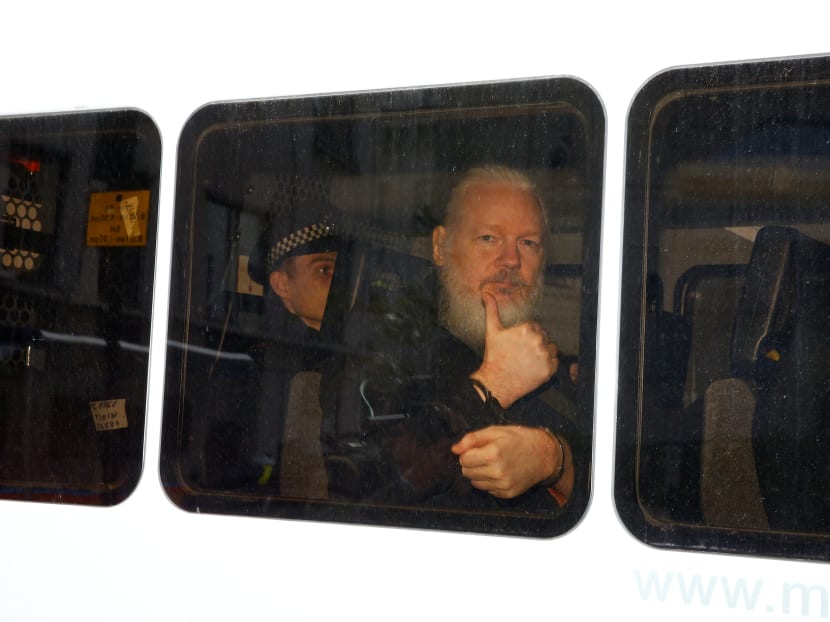Explainer: All you need to know about the Julian Assange story
SINGAPORE — Almost seven years since he skipped bail to avoid being extradited to Sweden over sexual assault allegations, WikiLeaks founder Julian Assange was arrested on Thursday (April 11) at the Ecuadorian Embassy in London, where he has been in asylum since 2012.

WikiLeaks founder Julian Assange is seen in a police van after he was arrested by British police outside the Ecuadorian embassy in London, Britain on April 11, 2019.
SINGAPORE — Almost seven years since he skipped bail to avoid being extradited to Sweden over sexual assault allegations, WikiLeaks founder Julian Assange was arrested on Thursday (April 11) at the Ecuadorian Embassy in London, where he has been in asylum since 2012.
He could be jailed up to 12 months in a British prison for failing to surrender to the court in the United Kingdom, and faces possible extradition to Sweden to answer rape charges and to the United States which accuse him of conspiring to steal classified information.
WHO IS JULIAN ASSANGE?
Assange, 47, a computer hacker, founded the controversial non-profit WikiLeaks in 2006. His organisation has since published classified information and news leaks provided by anonymous sources.
Assange and WikiLeaks first made international headlines in 2007 when it published a US Army manual from 2003 on “standard operating procedures” for a prison in Guantanamo Bay, Cuba.
The manual revealed controversial methods such as how prisoners were kept in isolation for two weeks in order to make them more compliant towards interrogators.
WikiLeaks made headlines again in 2010 when it published large troves of classified US diplomatic cables, and US documents pertaining to the Afghan War and the Iraq War.
In the lead-up to the US presidential election in 2016, WikiLeaks released nearly 20,000 Democratic National Committee (DNC) emails and 2,000 emails from Mr John Podesta, Hillary Clinton’s campaign manager, damaging Mrs Clinton’s presidential bid.
The emails, which US intelligence claimed were stolen by hackers hired by the Russian government, appeared to show that the DNC favoured Mrs Clinton over Mr Bernie Sanders, her rival for the Democratic presidential nomination.
WHY WAS ASSANGE IN ECUADOR'S EMBASSY IN LONDON?
In August 2010, the Swedish Prosecutor’s Office filed an arrest warrant for Assange for alleged sex crimes, after two separate allegations — one of rape and one of molestation — surfaced.
A British court ruled in February 2011 that Assange should be extradited to Sweden for questioning.
His lawyers appealed the court’s ruling, but the decision to extradite him was upheld by the High Court in November 2011 and the Supreme Court in May 2012.
Assange then applied for political asylum at Ecuador’s embassy in London, which was granted to him in August 2012 because of fears that his rights might be violated if he were to be extradited.
Article 22 of the Vienna Convention on Diplomatic Relations stipulates that police and security officials cannot enter a diplomatic building, unless they have the consent of the head of the diplomatic mission.
This meant that Assange could only be arrested by British police once he left the building. For the last seven years, he remained in the Ecuadorian embassy.
WHY AND HOW WAS ASSANGE ARRESTED THEN?
Ties between Assange and Ecuador have grown increasingly strained since 2017.
Ecuador restricted Assange’s Internet connection to prevent him from interfering in other countries’ affairs last March, and gave him a new set of house rules at the embassy in October last year — which includes avoiding online comments about political issues and taking better care of his cat.
Assange’s position has not been helped by the election of a new Ecuadorian president, Mr Lenin Moreno, in 2017 — in place of the incumbent Mr Rafael Correa who had granted him asylum and given him his unconditional support.
On Thursday, Mr Moreno described Assange’s behaviour as “discourteous and aggressive” in a video statement on Twitter, and said that WikiLeaks has made “hostile and threatening declarations” against Ecuador.
“Ecuador has sovereignly decided to terminate the diplomatic asylum granted to Mr Assange in 2012,” he said.
The London Metropolitan Police said in a statement that it was “invited into the embassy by the Ecuadorian ambassador, following the Ecuadorian government’s withdrawal of asylum”.
This effectively allowed them to arrest Assange without contravening the Vienna Convention, for violating his bail conditions in 2012.
WHAT NOW?
On April 11, Assange was found guilty of failing to surrender to the British court and now faces up to 12 months in a British prison.
Swedish investigations against Assange were dropped in 2017, with prosecutors saying there were difficulties in serving him formal notice of the allegations against him.
However, Sweden’s then-director of public prosecutions said that investigations could be re-opened if Assange returned to Sweden before the statute of limitation on the case expires in August next year.
Ms Elisabeth Massi Fritz, a lawyer for one of Assange’s two accusers, said in a statement on Twitter on April 11: “We are going to do everything we possibly can to get the Swedish police investigation re-opened so that Assange can be extradited to Sweden and prosecuted for rape.”
US prosecutors have also announced charges against Assange following his arrest, accusing him of conspiring with former US military analyst Chelsea Manning, who was involved in the 2010 leaks, to gain access to a government computer.
Assange could be extradited to the US, where he faces up to five years in prison if convicted.






